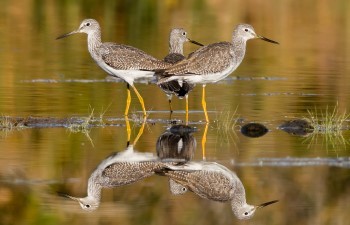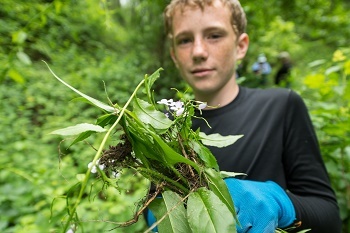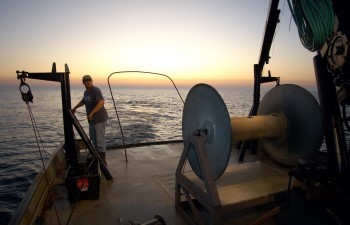|
Here are just a few of this week's stories from the Michigan Department of Natural Resources:?
See other news releases, Showcasing the DNR stories, photos and other resources at Michigan.gov/DNRPressRoom.
PHOTO FOLDER: Larger, higher-res versions of the images used below, and others, are available in this folder.

Across Michigan, new fledglings have left their nests and are learning what it means to be a bird. Mid-July is also when shorebirds begin their fall journeys, kicking off the migration season.
These early migrants will move through the state?s coastal mudflats, wetlands, beaches and flooded fields into August. Some will fly as far south as the coasts of Chile and Argentina! Michigan?s wetlands provide shorebirds and other migratory birds with water, food and shelter during their long voyages.
Because wetlands are such a valuable resource for migrating birds, many of these birds follow the Great Lakes coastlines on their journeys south. That makes wetlands and lakeshores some of the best habitats for birdwatchers to visit for shorebird migration. Prepare for your next birding trip by keeping a close eye on the weather. Cold fronts and storm events can result in an awe-inspiring migratory movement known as a ?fall-out," where flocks rapidly descend from the sky to seek shelter from detrimental weather. Check your weather regularly or visit BirdCast, a special forecast tool that predicts when birds will be moving near you.
Here are a few Michigan migratory shorebirds to look for over the next month, with tips on how to identify them:
|

-
Piping plover: This beloved, endangered shorebird has a pale grey back and head cap. Nonbreeding adult and juvenile piping plovers lack a complete breast band ? a colored stripe that encircles the breast. You can help protect this endangered shorebird by sharing the shore and giving it space to nest, rest and migrate. If you encounter a plover with a research leg band, report your sighting. ?
-
Semipalmated plover: Sometimes confused with the endangered piping plover, the small semipalmated plover is darker overall and has a complete breast band.?Their name comes from their partially webbed feet, which helps them wade in shallow water.
-
Greater yellowlegs: Sometimes confused for solitary sandpipers, greater yellowlegs are larger with longer, bright yellow legs.?
-
Lesser yellowlegs: The lesser yellowlegs is smaller than the greater yellowlegs with a shorter, thinner bill and less streaking on the neck.?
-
Spotted sandpiper: This sandpiper often walks in a crouched position and bobs its tail up and down almost constantly. It has spots on its breast and belly, which disappear as it molts out of breeding plumage.
Submit your shorebird observations to eBird and help map these species. MI Birds, a public outreach and engagement program created by Audubon Great Lakes and the DNR, aims to increase all Michiganders? engagement with public lands important for birds and local communities. Follow them on Facebook, Instagram and Twitter or sign up for email updates. You can find more tips and info at Michigan.gov/Birding. Happy birding!
|

Treatment season for many invasive species is underway across the state, and the NotMISpecies webinar series is focused on common questions about control and management. Whether you?re thinking about tackling invasives on your land or wondering how to control phragmites (a common reed that can grow up to 15 feet tall!) or invasive aquatic plants, take advantage of expert advice in upcoming sessions.
- Sept. 22 ? Yooper Troopers: Lessons Learned Controlling Phragmites in Michigan?s U.P.
- Oct. 6 ? There?s a Lamprey in my Classroom! Infusing Invasive Species Education into Statewide Programs.
- Nov. 10 ? Treat Me Right! Rules, Regulations and Best Practices for Controlling Aquatic Invasive Species in Michigan?s Inland Lakes.
If calendar conflicts keep you from catching a live webinar, no worries ? recordings of past presentations are available to enjoy at your convenience. Past topics include everything from what you need to know about didymo (or ?rock snot?) and using environmental DNA to detect invasive species, to actions boaters can take to prevent aquatic invasives from hitchhiking to new locations.
In fact, the recording of this morning?s webinar (Not in My Backyard! Managing Invasives with Help from CISMAs) offering help with garlic mustard, Japanese knotweed and invasive shrubs, soon will be posted online.
More information, registration details and past recordings for all webinars are available at the NotMISpecies webinar series webpage.
Questions? Contact Joanne Foreman at [email protected].
|

Just about every angler has a favorite fishing spot and certain species that make the chase especially rewarding. Whether you?re after salmon on the Big Sable River, walleye on West Lake, muskie on the Muskegon River or just hoping for a little tug on the line at your local fishing hole, odds are good that DNR fisheries staff and partners played a big part in improving that experience.
Fishing is big recreational business in Michigan, and a shared outdoor tradition that spans generations ? nearly 1.2 million people purchased licenses in 2021, for fishing on all types of waters, from tiny inland streams to the powerful Great Lakes.
Protecting and improving the health and abundance of the fish in those waters requires quality facilities, effective tools and adequate funding. In case you missed it, DNR fish production and research got a $34 million boost in the state?s 2023 budget, directing $30 million for critical fish hatchery infrastructure upgrades and $4 million for the purchase of a new Great Lakes survey vessel. The funding will help address a backlog of facility needs that directly affect the DNR?s ability to rear and safeguard fish for stocking, and enable the department to replace the SV Steelhead, which has been in operation for 54 years.
Questions? Contact Ed Eisch at 231-499-4118.
|
|